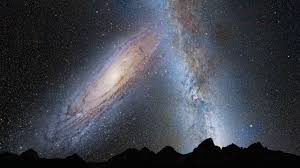Nearby galaxy to slam into Milky Way

Islamabad: As if battered post-Christmas finances, a looming disorderly Brexit and the prospect of a fresh nuclear arms race were not enough to dampen spirits, astronomers have declared that a nearby galaxy will slam into the Milky Way and could knock our solar system far into the cosmic void.
The unfortunate discovery was made after scientists ran computer simulations on the movement of the Large Magellanic Cloud (LMC), one of the many satellite galaxies that orbits the Milky Way. Rather than circling at a safe distance, or breaking free of the Milky Way’s gravitational pull, the researchers found the LMC is destined to clatter into the galaxy we call home.
At the moment, the LMC is estimated to be about 163,000 light years from the Milky Way and speeding away at 250 miles per second. But simulations by astrophysicists at Durham University show that the LMC will eventually slow down and turn back towards us, ultimately smashing into the Milky Way in about 2.5 billion years’ time.
While individual stars and planets are unlikely to collide, the arrival of a galaxy weighing as much as 250 billion suns will still wreak havoc. “The whole of the Milky Way will be shaken and the entire solar system could be ejected into outer space,” said Carlos Frenk, director of the Institute for Computational Cosmology at Durham. “If that happens, I don’t see how our descendants, if we have any, will be able to withstand it.”
It is not all doom and gloom though. The odds of the collision casting the solar system into a more rarefied region of space are slim, the researchers report in the Monthly Notices of the Royal Astronomical Society. Marius Cautun, the first author on the paper, said the chances of cosmic exile were about 1-3%.
In one sense, the collision with the LMC is long overdue. The Milky Way is an oddball among spiral galaxies. The halo of stars that surrounds its galactic disc contains far fewer stars than comparable galaxies. But that is not all. The supermassive black hole at the Milky Way’s centre is paltry, only one-tenth as massive as those found at the hearts of similar galaxies.
The galactic merger will change all of this. “Once the LMC gets gobbled up by the Milky Way, our galaxy will become a beautiful, normal spiral,” said Frenk. “Most of the halo will become stars from the LMC and the black hole will gorge on this sudden unexpected abundance of fuel and it will go berserk.”
The LMC holds vast amounts of gas that will be devoured by the supermassive black hole until it reaches up to 10 times its present mass. As it feeds, the black hole will become “active” and send out powerful jets of high-energy radiation. While intense beams of gamma radiation may potentially spark mass extinctions, the radiation driven by the black hole is unlikely to pose a threat to any life that may exist on Earth, the authors write.
In the past, astronomers who concerned themselves with the demise of the Milky Way focused their attention on the upcoming collision with the Andromeda galaxy. At five times the mass of the Large Magellanic Cloud, Andromeda could completely destroy the Milky Way when the two collide. That cosmic catastrophe is expected in about four billion years’ time.
But the merger with the LMC could postpone the cataclysm, said Frenk. “One of the by-products of the collision with the LMC is it will delay armageddon,” he said. “It will move the Milky Way a bit and that may buy us a couple of billion years.
“The LMC is big but it won’t completely destroy our galaxy,” he said. “It’ll produce these amazing fireworks, but it doesn’t have the mass to create a huge disturbance. The collision with Andromeda really will be armageddon. That really will be the end of the Milky Way as we know it.”





